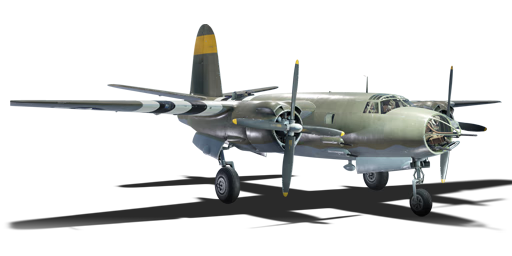



In March 1939, the USAAF issued a design specification for a twin-engine medium bomber with speed and range as priorities. The Glenn L. Martin company submitted their design four months later, which was accepted for contract for what would be later known as the Martin B-26 Marauder. After entering service in 1941, the Marauder became notorious for its tendency to crash during landing due to its short wingspan resulting in a high stall speed. This forced pilots to land at a dangerously fast approach speed, often with fatal results. Because of this, along with the overall instability during flight that was uncomfortable for anyone on board, the Marauder was hated by its crews and spawned numerous derogatory nicknames; chief among these were the "Widowmaker" and the "Martin Murderer".
In response to numerous fatal crashes, in 1942 the Truman Committee demanded Martin rectify the Marauder's flaws or else the contract for the aircraft would be cancelled entirely. This resulted in the B-26B variant, featuring an extended wingspan and larger stabiliser and rudder to improve the overall flight characteristics and reduce the stall speed. After the problems were ironed out, the Marauder proved itself to be a very reliable and durable bomber, with the lowest loss rate of any bombers operated by the USAAF. One aircraft in particular, the Flak-Bait, was notable for having survived 207 sorties over Europe, the most of any American aircraft in World War II.
Introduced in Update "Wind of Change", the B-26B served as a stopgap between the B-25 Mitchell and the B-17E Flying Fortress, featuring frontal machine guns to strafe ground targets like the Mitchell, while also being closer in size and payload to the Flying Fortress. As expected for a plane of this size, the Marauder is quite sluggish, though in return it also features heavy ordnance for its class, allowing it to tackle any kinds of ground or naval targets.
flaps
flaps
flaps
brake
| Belt | Belt filling | Armor penetration (mm) at a distance: | |||||
|---|---|---|---|---|---|---|---|
| 10 m | 100 m | 500 m | 1000 m | 1500 m | 2000 m | ||
| T/Ball/Ball/I/AP-I | 28 | 26 | 18 | 11 | 7 | 4 | |
| AP-I/AP-I/AP-I/T/I | 28 | 26 | 18 | 11 | 7 | 4 | |
| T/AP/AP/AP/AP-I/I | 30 | 27 | 20 | 13 | 9 | 6 | |
| T/T/T/T/T/AP-I | 28 | 26 | 18 | 11 | 7 | 4 | |
| AP/AP-I/AP-I/I/I | 30 | 27 | 20 | 13 | 9 | 6 | |
| Belt | Belt filling | Armor penetration (mm) at a distance: | |||||
|---|---|---|---|---|---|---|---|
| 10 m | 100 m | 500 m | 1000 m | 1500 m | 2000 m | ||
| T/AP/I/AP-I | 30 | 27 | 20 | 13 | 9 | 6 | |
| AP/AP/AP/T | 30 | 27 | 20 | 13 | 9 | 6 | |
| AP-I/AP-I/AP-I/T | 28 | 26 | 18 | 11 | 7 | 4 | |
| Belt | Belt filling | Armor penetration (mm) at a distance: | |||||
|---|---|---|---|---|---|---|---|
| 10 m | 100 m | 500 m | 1000 m | 1500 m | 2000 m | ||
| T/AP/I/AP-I | 30 | 27 | 20 | 13 | 9 | 6 | |
| AP/AP/AP/T | 30 | 27 | 20 | 13 | 9 | 6 | |
| AP-I/AP-I/AP-I/T | 28 | 26 | 18 | 11 | 7 | 4 | |












Flight performance | |
|---|---|
Survivability |
|---|
Weaponry | ||
|---|---|---|